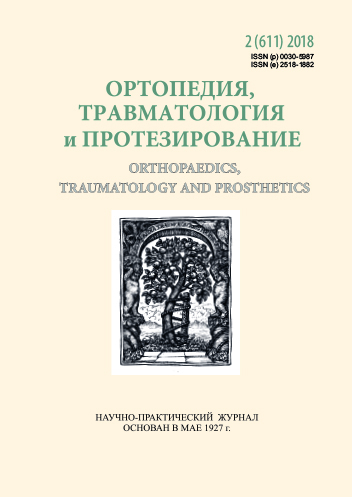Diagnostics of scapho-lunate ligament injury
DOI:
https://doi.org/10.15674/0030-59872018249-56Keywords:
scapho-lunate ligament, diagnostics, X-ray, ultrasoundAbstract
The main problem in the diagnostics of scapho-lunate ligament injury is the relative rare detailed clinical and radiologic picture, the lack of information and pronounced dissonance between anatomic types if injuries and clinical symptoms.
Methods: we examined 63 patients (47 men, 16 female, average age 34.4 years) who had surgery treatment because of scapho-lunate ligament injury. We assessed the informative (sensitivity/specificity) of clinical signs and data obtained with X-ray, computer tomography, magnetic resonance investigation and ultrasound.
Results: in the basis of scapho-lunate ligament injury lies the progressive instability with extensor contracture and degenerative changes in radial joint. The diagnostics of the early stages of ligament injury is based on anamnesis morbid and quite sensitive clinical tests: Watson — 96 %, scapho-lunate displacement — 53 %, «flexed wrist-extension fingers» — 75 %. But because of their low specificity (4–6 %) additional methods of examination are needed — X-ray, computer tomography, magnetic resonance investigation, ultrasound.
Conclusions: for those injuries which accompined with static instability we use X-ray or computer tomography in order to identify such signs as «Terry Thomas» symptom, «ring», scaphoid shortening. Their sensitivity at the IV–VI stages is almost 100 %. In cases of I–III stages of ligament injury the most specificity is magnetic resonance investigation study. Ultrasound is high informative at ligament injury and carpal instability, but it does not give the full picture of disorganization of wrist joint, it does not give opportunity to divide the stage of injury and choose the method of treatment, so it can be as additional method of examinationReferences
- Kuo, C. E., & Wolfe, S. W. (2008). Scapholunate Instability: Current Concepts in Diagnosis and Management. The Journal of Hand Surgery, 33(6), 998-1013. doi: https://doi.org/10.1016/j.jhsa.2008.04.027
- Chennagiri, R. J., & Lindau, T. R. (2013). Assessment of scapholunate instability and review of evidence for management in the absence of arthritis. Journal of Hand Surgery (European Volume), 38(7), 727-738. doi: https://doi.org/10.1177/1753193412473861
- Mayfield, J. K., Johnson, R. P., & Kilcoyne, R. K. (1980). Carpal dislocations: Pathomechanics and progressive perilunar instability. The Journal of Hand Surgery, 5(3), 226-241. doi: https://doi.org/10.1016/s0363-5023(80)80007-4
- Destot, E. (1925). Injuries of the wrist: aradiological study (pp. 101–113). London: Ernest Benn Ltd.
- Linscheid, R. L., Dobyns, J. H., Beabout, J. W., & Bryan, R. S. (1972). Traumatic Instability of the Wrist. The Journal of Bone & Joint Surgery, 54(8), 1612-1632. doi: https://doi.org/10.2106/00004623-197254080-00003
- Nelson, D. L. (1997). The importance of the physical examination. Hand clinics, 13(1), 13–15.
- Andersson, J. K., Andernord, D., Karlsson, J., & Fridén, J. (2015). Efficacy of magnetic resonance imaging and clinical tests in diagnostics of wrist ligament injuries: A systematic review. Arthroscopy: The Journal of Arthroscopic & Related Surgery, 31(10), 2014-2020.e2. doi: https://doi.org/10.1016/j.arthro.2015.04.090
- Andersson, J. K., & Garcia-Elias, M. (2012). Dorsal scapholunate ligament injury: a classification of clinical forms. Journal of Hand Surgery (European Volume), 38(2), 165-169. doi: https://doi.org/10.1177/1753193412441124
- Watson, H. K., Ashmead, D., & Makhlouf, M. V. (1988). Examination of the scaphoid. The Journal of Hand Surgery of the American Society for Surgery of the Hand, 13(5), 657–560.
- Watson, K. H., & Weinzweig, J. (2001). The wrist. Philadelphia: Lippincott Williams & Wilkins.
- Mann, F. A., Wilson, A. J., & Gilula, L. A. (1992). Radiographic evaluation of the wrist: what does the hand surgeon want to know? Radiology, 184(1), 15-24. doi: https://doi.org/10.1148/radiology.184.1.1609073
- Gilula, L. A., & Yin, Y. (1996). Imaging of the wrist and hand (pp. 539–540). Philadelphia: W.B. Saunders.
- Greditzer, H. G., Zeidenberg, J., Kam, C. C., Gray, R. R., Clifford, P. D., Mintz, D. N., & Jose, J. (2016). Optimal detection of scapholunate ligament tears with MRI. Acta Radiologica, 57(12), 1508-1514. doi: https://doi.org/10.1177/0284185115626468
- Lee, R. K., Griffith, J. F., Ng, A. W., Nung, R. C., & Yeung, D. K. (2016). Wrist Traction During MR Arthrography Improves Detection of Triangular Fibrocartilage Complex and Intrinsic Ligament Tears and Visibility of Articular Cartilage. American Journal of Roentgenology, 206(1), 155-161. doi: https://doi.org/10.2214/ajr.15.14948
- Vovchenko, G. Ya., Sergienko, R. O., Tymoshenko, S. V., & Filippchuk, V. V. (2011). Guide for ultrasound examination in traumatology and orthopedics. Joints Etudes of modern ultrasound diagnostics. Kiev: Ukrainian Doppler Club.
Downloads
How to Cite
Issue
Section
License
Copyright (c) 2018 Sergey Strafun, Sergii Timoshenko, Katerina Radchenko

This work is licensed under a Creative Commons Attribution 4.0 International License.
The authors retain the right of authorship of their manuscript and pass the journal the right of the first publication of this article, which automatically become available from the date of publication under the terms of Creative Commons Attribution License, which allows others to freely distribute the published manuscript with mandatory linking to authors of the original research and the first publication of this one in this journal.
Authors have the right to enter into a separate supplemental agreement on the additional non-exclusive distribution of manuscript in the form in which it was published by the journal (i.e. to put work in electronic storage of an institution or publish as a part of the book) while maintaining the reference to the first publication of the manuscript in this journal.
The editorial policy of the journal allows authors and encourages manuscript accommodation online (i.e. in storage of an institution or on the personal websites) as before submission of the manuscript to the editorial office, and during its editorial processing because it contributes to productive scientific discussion and positively affects the efficiency and dynamics of the published manuscript citation (see The Effect of Open Access).














